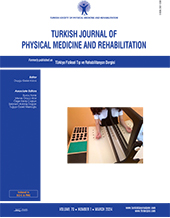Pain types and risk factors in post-COVID-19
2 Department of Physical Therapy and Rehabilitation, Istanbul Kanuni Sultan Süleyman Training and Research Hospital, Istanbul, Türkiye
3 Department of Physical Medicine and Rehabilitation, Istanbul University Istanbul Faculty of Medicine, Istanbul, Türkiye
4 Department of Physical Therapy and Rehabilitation, Istanbul Physical Medicine and Rehabilitation Training and Research Hospital, Istanbul, Türkiye
5 Department of Physical Medicine and Rehabilitation, Yozgat Bozok University Faculty of Medicine, Yozgat, Türkiye
6 Department of Physical Medicine and Rehabilitation, Gaziantep University Research Hospital, Gaziantep, Türkiye
7 Department of Physical Medicine and Rehabilitation, Hitit University Faculty of Medicine, Çorum, Türkiye
8 Department of Physical Medicine and Rehabilitation, Bursa Yüksek İhtisas Training and Research Hospital, Bursa, Türkiye
9 Department of Physical Medicine and Rehabilitation, Süleyman Demirel University Faculty of Medicine, Isparta, Türkiye
10 Department of Physical Medicine and Rehabilitation, Abant Izzet Baysal University Faculty of Medicine, Bolu, Türkiye
11 Department of Physical Medicine and Rehabilitation, Medikent Hospital, Lüleburgaz, Türkiye
12 Department of Physical Medicine and Rehabilitation, Tekirdağ Namık Kemal University Faculty of Medicine, Tekirdağ, Türkiye
13 Department of Physical Therapy and Rehabilitation, Istanbul Sancaktepe Ilhan Varank Training and Research Hospital, Istanbul, Türkiye
14 Department of Physical Medicine and Rehabilitation, Ankara University Faculty of Medicine, Ankara, Türkiye
15 Department of Physical Medicine and Rehabilitation, Güven Hospital, Ankara, Türkiye DOI : 10.5606/tftrd.2024.13828 Objectives: This study aims to accurately evaluate pain lasting longer than three months and falls under the category of chronic pain and to determine the risk factors to follow up and treat properly and to develop appropriate diagnostic and treatment algorithms.
Patients and methods: Between March 2021 and December 2021, a total of 437 patients (162 males, 275 females; mean age: 44±14.6 years; range, 12 to 82 years) who were referred to the participating centers due to pain complaints and were diagnosed with post-COVID-19 condition according to the criteria defined by the World Health Organization (WHO) were included in the study. The patients were divided into three groups as nociceptive pain, neuropathic pain, and central sensitization, based on the physician's clinical evaluation and the Self-Report Leeds Assessment of Neuropathic Symptoms and Signs (S-LANSS) and Central Sensitization Inventory scores.
Results: The most common diagnosis was nociceptive pain followed by central sensitization. Patients with nociceptive pain had less pain. It was found that not exercising regularly, having a chronic disease and being a woman were risk factors for central sensitization, having thyroid disease before COVID-19, and defining the current pain as very severe were risk factors for neuropathic pain.
Conclusion: In the evaluation of post-COVID-19 pain, neuropathic pain and central sensitization should be also considered in addition to nociceptive pain and the severity of pain, systemic diseases and physical activity should be questioned.
Keywords : Central sensitization, neuropathic pain, nociceptive pain, pain, physical activity, post-COVID-19 conditions

















